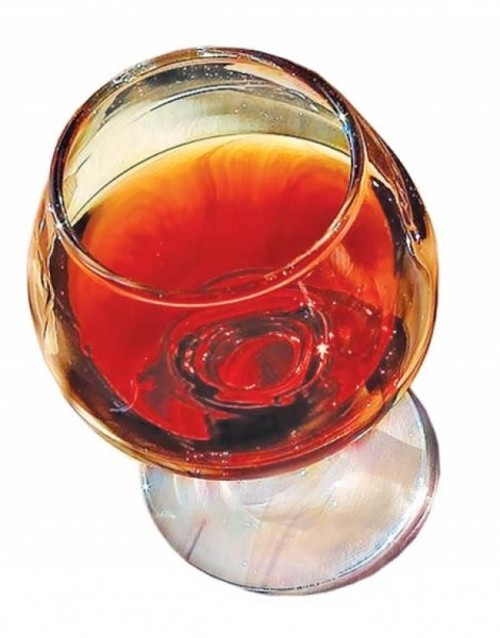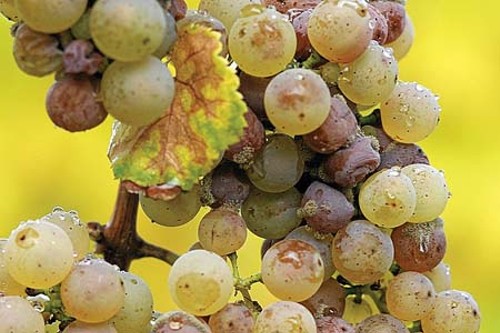Whether it was a square of chocolate,
a bite of a pastry or a spoonful
of ice cream, a meal was not
complete for my mom until she gave in
to her sweet tooth. My father preferred
his glucose in liquid form—liters of soda.
Either way, growing up, I had access to
virtual mounds of sugar. I have little to no
doubt that this has manifested itself into
my penchant for Port, ice wine and other
sweet libations.
The main component necessary for the
production of wine starts with the natural
sugars found in grapes. Isolating this component
during the cultivation or production
of wine will yield what is referred to as
“stickies” and “the nectar of the gods”: Port
and Ice Wine, respectively. Regardless of the
style or country of origin, these wines are
dense and highly aromatic, and a few ounces
are a fine option for dessert in a glass.
The basic formula for turning grape
juice into wine is simple. After grapes are
crushed, they come into contact with yeast
cells that convert sugars into alcohol and
bubbles. Those bubbles are what gives
Champagne its sparkle, but that’s a whole
other story. During the fermentation of Port,
the addition of a neutral spirit—think
flavorless brandy—is added.
This boosts alcohol levels
to about 18-20 percent,
and leaves unfermented
natural grape sugars in
the finished wine. This
method was employed
during the 18th century
after many barrels
destined for
England from northern
Portugal arrived
badly spoiled or oxidized.
Following this
fix, the Brits got their
wine and the world was
given an array of differentstyled
Ports—from the fiery,
young and fruity Ruby to the
classy, polished and nutty aged
Tawny.
Wine has an alarming amount
of water; they say it’s about 80 percent.
The remainder is composed of acids,
esters, proteins, minerals and sugars,
among other things. As any fruit ripens,
sugar content naturally increases as acid
levels drop. Try a darker, ripe raspberry
next to an under-ripe pink raspberry
and notice how tart the under-ripe pink
berry is compared to the sweeter, darker
berry. Late harvest wines are just that:
wine made from grapes left on the vine
long enough until sugars soar and
acids plummet.
A more enticing and
balanced late-harvest
version occurs when
a vineyard is graced
with a fungus euphemistically
referred
to as noble rot. This
occurs in regions
with higher humidity
such as the maritime
vineyards of
Sauternes, France.
The fungus pierces
the grape skins while
attaching itself,
which allows for
the natural evaporation
of water, thus
concentrating the
sugars and acids. The
finished wines are less
cloyingly sweet due to the higher ratio of
acidity—exactly what lemons do for sweet
tea. These wines have flavors reminiscent
of honeyed peaches and apricots, layered
on a rich, dense palate with accents of
spice.
In colder climates such as Canada’s, the
likelihood of frost and below-freezing temperatures
following harvest allow for the
production of ice wine. A very similar tale
of concentration is played out in these frigid
vineyards. When the grapes form a solid
core of ice, vineyard workers painstakingly
begin harvesting, assisted by floodlights
and headlamps in the middle of the night.
The grapes are transported quickly and
pressed ASAP. The frozen ice crystals are
left in the press and the concentrated grape
sugars and acids are made into a syrupy,
tropical, poignant dessert wine appropriately
referred to as the nectar of the gods.
With the amount of concentration and
depth of flavors put forth by these sweeter
wines, they’re certainly worth a sip or
two—especially when the nagging of your
sweet tooth is as audible as mine.
Speaking of Drink, ,dessert
-
Sipping Portugal
Vinho Verde is the perfect spring/summer sipper.
- May 10, 2011
-
Wine & Dine
A bounty of local wine dinners in May.
- May 3, 2011
-
Pinot & Pedicures
Tasting Robert Sinskey Wines in the most unusual of venues.
- Apr 26, 2011
- More »
More by Louis Koppel
-
The History & Buzz About Wine
A brief history of the nectar and our attraction to it.
- Sep 21, 2010
-
How to Decipher Wine Descriptions
Purple Prose & White Lies: How to unravel the tasting note.
- Aug 10, 2010
-
Wine & Wood
Get your mind out of the gutter; we’re talking about oak.
- May 25, 2010
- More »





